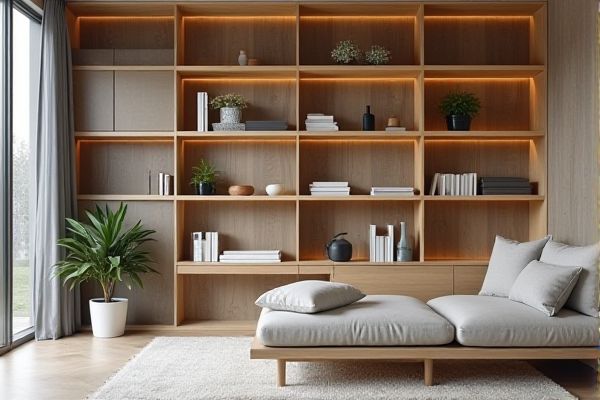
Narrow shelving offers easier access and better visibility for smaller items, while deep shelving maximizes storage capacity for bulkier goods but may make organization more challenging. Explore the rest of the article to determine which shelving option best suits your storage needs.
Table of Comparison
| Feature | Narrow Shelving | Deep Shelving |
|---|---|---|
| Storage Capacity | Limited, ideal for small items | High, suitable for bulky items |
| Accessibility | Easy access to all items | Harder to reach items at the back |
| Space Efficiency | Maximizes narrow spaces | Better for wide spaces |
| Use Case | Retail displays, bookshelves | Warehouse storage, bulk inventory |
| Cost | Generally lower | Usually higher |
| Installation | Simple and lightweight | Requires robust support |
Introduction to Narrow vs Deep Shelving
Narrow shelving maximizes space efficiency by fitting into tighter areas and offering easy access to items, making it ideal for small or crowded rooms. Deep shelving provides greater storage capacity per unit, accommodating larger or bulkier items while requiring more floor space. Understanding your storage needs and available space helps you select the right option to optimize organization and accessibility.
Key Differences Between Narrow and Deep Shelving
Narrow shelving typically ranges from 6 to 12 inches in depth, making it ideal for storing smaller items and maximizing aisle space in tight areas. Deep shelving, often 18 to 24 inches or more, accommodates larger, bulkier products but requires more floor space and can reduce accessibility. The key differences lie in storage capacity, spatial efficiency, and the type of items best suited for each shelf depth.
Space Optimization: Narrow Shelving Benefits
Narrow shelving maximizes space optimization by fitting seamlessly into tight areas where deep shelving would cause congestion, allowing you to utilize vertical storage more efficiently. These shelves improve accessibility and organization by keeping items visible and easy to reach, preventing the clutter that often accompanies deep shelving units. By choosing narrow shelving, your storage solution becomes more adaptable, promoting better airflow and reducing wasted space in small rooms or closets.
Storage Capacity: Deep Shelving Advantages
Deep shelving offers significantly higher storage capacity compared to narrow shelving by accommodating larger or bulkier items efficiently. Its increased depth maximizes vertical and horizontal space utilization, reducing the need for multiple shelving units. This optimization is ideal for warehouses and storage facilities requiring robust inventory management and space-saving solutions.
Accessibility and Organization Considerations
Narrow shelving enhances accessibility by allowing easier reach and visibility of stored items, making it ideal for frequently used spaces or smaller rooms. Deep shelving maximizes storage capacity and is better suited for large or bulky items but may cause difficulty in accessing items placed at the back, potentially leading to disorganization. Organizing narrow shelving typically involves consistent categorization for quick retrieval, while deep shelving requires strategic placement and the use of storage bins or dividers to maintain order and improve accessibility.
Best Uses for Narrow Shelving
Narrow shelving is ideal for small spaces, tight corners, and areas requiring easy access to frequently used items, making it perfect for kitchens, bathrooms, and offices. Its slim design maximizes vertical storage without consuming much floor space, helping you organize books, spices, or decorative items efficiently. Choosing narrow shelving enhances storage flexibility and keeps your essentials within reach while maintaining a clean and open environment.
Ideal Applications for Deep Shelving
Deep shelving is ideal for storing bulky or large items that require more space, such as heavy equipment, oversized boxes, or industrial supplies. This type of shelving maximizes storage capacity in warehouses, garages, and retail backrooms where depth accommodates diverse inventory sizes. Your facility benefits from deep shelving when efficient use of vertical and horizontal space is essential for organizing and accessing large or dense goods.
Design and Aesthetic Impacts
Narrow shelving enhances visual openness and creates a minimalist aesthetic by reducing visual clutter and allowing more wall space to show, ideal for small or modern interiors. Deep shelving offers more storage capacity and supports the display of larger decorative items, but can dominate a room and create a bulkier appearance that may overwhelm compact spaces. Choosing between narrow and deep shelving fundamentally influences room proportions, perceived spaciousness, and the overall cohesiveness of interior design elements.
Cost Comparison: Narrow vs Deep Shelving
Narrow shelving typically costs less due to reduced material usage and easier installation compared to deep shelving, which requires sturdier construction to support heavier loads and increased depth. Deep shelving often demands customized solutions and additional support brackets, driving up overall expenses. Your choice should balance budget constraints with storage needs, as narrow shelving offers cost efficiency while deep shelving provides greater capacity.
Choosing the Right Shelving for Your Space
Narrow shelving maximizes space efficiency in compact areas, providing easy access to items without overwhelming the room. Deep shelving offers greater storage capacity, ideal for bulkier items but may require more careful organization to avoid clutter. Understanding your storage needs and available space helps you choose shelving that optimizes both functionality and aesthetic appeal.
 homyna.com
homyna.com